Case-Control Study: Self-Reported Sleep and Breast Cancer Risk
VerifiedAdded on 2023/01/19
|8
|2862
|78
Case Study
AI Summary
This case study critically examines a research article investigating the correlation between self-reported sleep duration, sleep quality, and breast cancer risk among Western Australian women. The original study employed a case-control design, surveying over 1000 women to assess the impact of sleep habits on breast cancer incidence, considering factors like working days sleep, non-working days sleep, and subjective sleep quality. The critique utilizes STROBE guidelines to evaluate the study's methodology, including the clarity of the title and abstract, the strength of the introduction, the appropriateness of the methods, and the presentation of results. The analysis points out both strengths, such as ethical approval and detailed setting descriptions, and weaknesses, including potential biases from self-reported data and the absence of a clear conclusion. Ultimately, the case study offers a comprehensive evaluation of the research, highlighting its contributions and limitations in understanding the complex relationship between sleep and breast cancer.
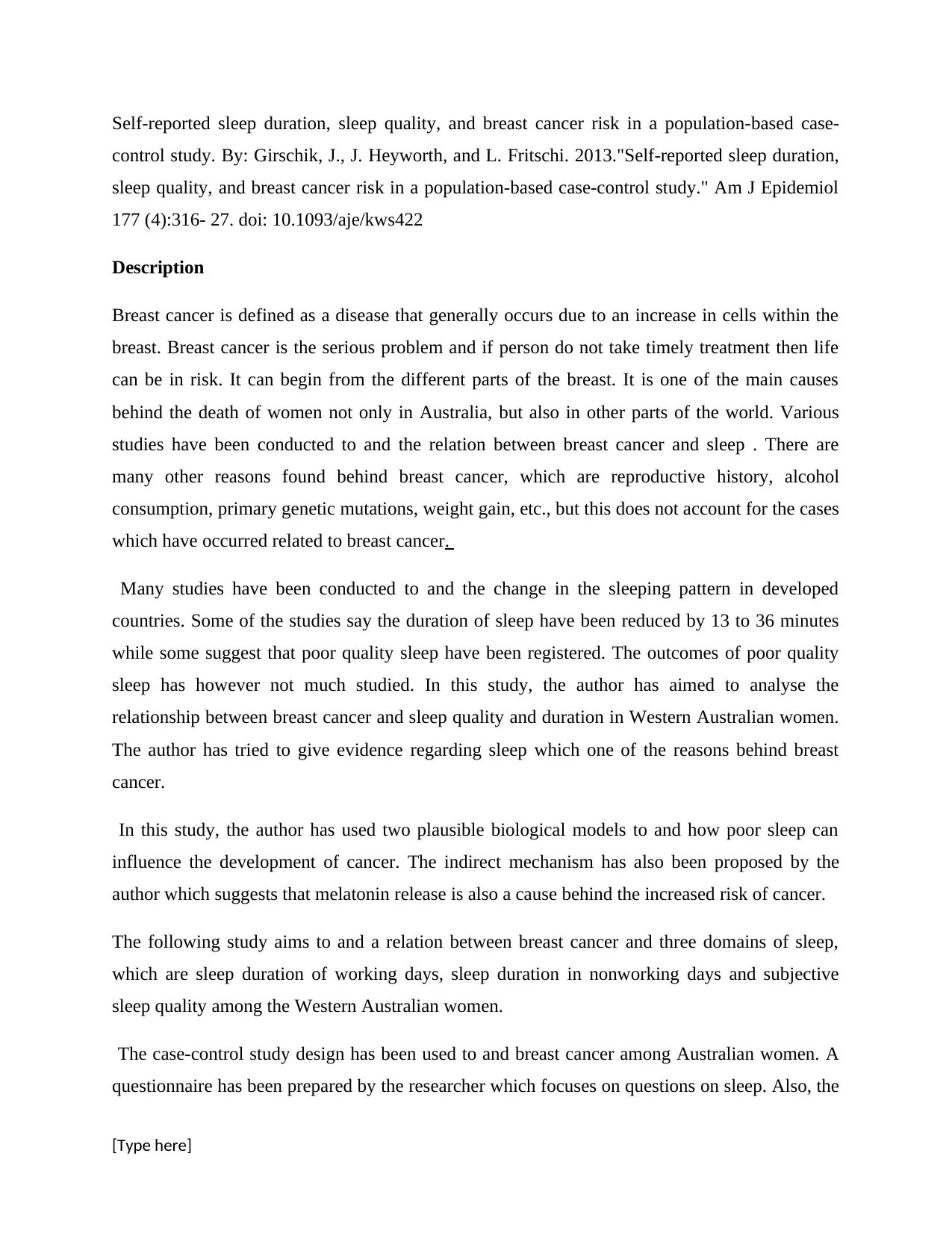
Self-reported sleep duration, sleep quality, and breast cancer risk in a population-based case-
control study. By: Girschik, J., J. Heyworth, and L. Fritschi. 2013."Self-reported sleep duration,
sleep quality, and breast cancer risk in a population-based case-control study." Am J Epidemiol
177 (4):316- 27. doi: 10.1093/aje/kws422
Description
Breast cancer is defined as a disease that generally occurs due to an increase in cells within the
breast. Breast cancer is the serious problem and if person do not take timely treatment then life
can be in risk. It can begin from the different parts of the breast. It is one of the main causes
behind the death of women not only in Australia, but also in other parts of the world. Various
studies have been conducted to and the relation between breast cancer and sleep . There are
many other reasons found behind breast cancer, which are reproductive history, alcohol
consumption, primary genetic mutations, weight gain, etc., but this does not account for the cases
which have occurred related to breast cancer.
Many studies have been conducted to and the change in the sleeping pattern in developed
countries. Some of the studies say the duration of sleep have been reduced by 13 to 36 minutes
while some suggest that poor quality sleep have been registered. The outcomes of poor quality
sleep has however not much studied. In this study, the author has aimed to analyse the
relationship between breast cancer and sleep quality and duration in Western Australian women.
The author has tried to give evidence regarding sleep which one of the reasons behind breast
cancer.
In this study, the author has used two plausible biological models to and how poor sleep can
influence the development of cancer. The indirect mechanism has also been proposed by the
author which suggests that melatonin release is also a cause behind the increased risk of cancer.
The following study aims to and a relation between breast cancer and three domains of sleep,
which are sleep duration of working days, sleep duration in nonworking days and subjective
sleep quality among the Western Australian women.
The case-control study design has been used to and breast cancer among Australian women. A
questionnaire has been prepared by the researcher which focuses on questions on sleep. Also, the
[Type here]
control study. By: Girschik, J., J. Heyworth, and L. Fritschi. 2013."Self-reported sleep duration,
sleep quality, and breast cancer risk in a population-based case-control study." Am J Epidemiol
177 (4):316- 27. doi: 10.1093/aje/kws422
Description
Breast cancer is defined as a disease that generally occurs due to an increase in cells within the
breast. Breast cancer is the serious problem and if person do not take timely treatment then life
can be in risk. It can begin from the different parts of the breast. It is one of the main causes
behind the death of women not only in Australia, but also in other parts of the world. Various
studies have been conducted to and the relation between breast cancer and sleep . There are
many other reasons found behind breast cancer, which are reproductive history, alcohol
consumption, primary genetic mutations, weight gain, etc., but this does not account for the cases
which have occurred related to breast cancer.
Many studies have been conducted to and the change in the sleeping pattern in developed
countries. Some of the studies say the duration of sleep have been reduced by 13 to 36 minutes
while some suggest that poor quality sleep have been registered. The outcomes of poor quality
sleep has however not much studied. In this study, the author has aimed to analyse the
relationship between breast cancer and sleep quality and duration in Western Australian women.
The author has tried to give evidence regarding sleep which one of the reasons behind breast
cancer.
In this study, the author has used two plausible biological models to and how poor sleep can
influence the development of cancer. The indirect mechanism has also been proposed by the
author which suggests that melatonin release is also a cause behind the increased risk of cancer.
The following study aims to and a relation between breast cancer and three domains of sleep,
which are sleep duration of working days, sleep duration in nonworking days and subjective
sleep quality among the Western Australian women.
The case-control study design has been used to and breast cancer among Australian women. A
questionnaire has been prepared by the researcher which focuses on questions on sleep. Also, the
[Type here]
Paraphrase This Document
Need a fresh take? Get an instant paraphrase of this document with our AI Paraphraser
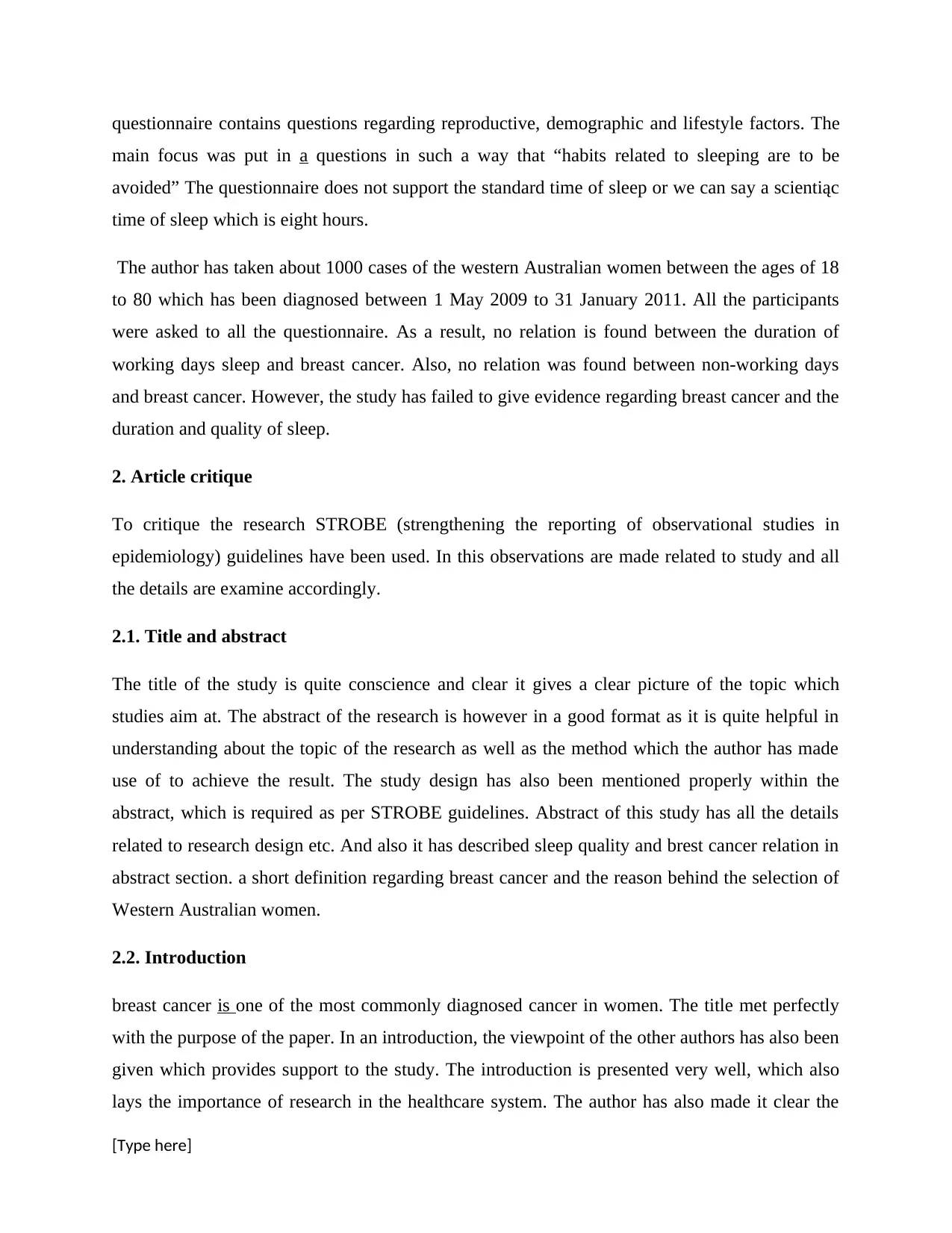
questionnaire contains questions regarding reproductive, demographic and lifestyle factors. The
main focus was put in a questions in such a way that “habits related to sleeping are to be
avoided” The questionnaire does not support the standard time of sleep or we can say a scientiąc
time of sleep which is eight hours.
The author has taken about 1000 cases of the western Australian women between the ages of 18
to 80 which has been diagnosed between 1 May 2009 to 31 January 2011. All the participants
were asked to all the questionnaire. As a result, no relation is found between the duration of
working days sleep and breast cancer. Also, no relation was found between non-working days
and breast cancer. However, the study has failed to give evidence regarding breast cancer and the
duration and quality of sleep.
2. Article critique
To critique the research STROBE (strengthening the reporting of observational studies in
epidemiology) guidelines have been used. In this observations are made related to study and all
the details are examine accordingly.
2.1. Title and abstract
The title of the study is quite conscience and clear it gives a clear picture of the topic which
studies aim at. The abstract of the research is however in a good format as it is quite helpful in
understanding about the topic of the research as well as the method which the author has made
use of to achieve the result. The study design has also been mentioned properly within the
abstract, which is required as per STROBE guidelines. Abstract of this study has all the details
related to research design etc. And also it has described sleep quality and brest cancer relation in
abstract section. a short definition regarding breast cancer and the reason behind the selection of
Western Australian women.
2.2. Introduction
breast cancer is one of the most commonly diagnosed cancer in women. The title met perfectly
with the purpose of the paper. In an introduction, the viewpoint of the other authors has also been
given which provides support to the study. The introduction is presented very well, which also
lays the importance of research in the healthcare system. The author has also made it clear the
[Type here]
main focus was put in a questions in such a way that “habits related to sleeping are to be
avoided” The questionnaire does not support the standard time of sleep or we can say a scientiąc
time of sleep which is eight hours.
The author has taken about 1000 cases of the western Australian women between the ages of 18
to 80 which has been diagnosed between 1 May 2009 to 31 January 2011. All the participants
were asked to all the questionnaire. As a result, no relation is found between the duration of
working days sleep and breast cancer. Also, no relation was found between non-working days
and breast cancer. However, the study has failed to give evidence regarding breast cancer and the
duration and quality of sleep.
2. Article critique
To critique the research STROBE (strengthening the reporting of observational studies in
epidemiology) guidelines have been used. In this observations are made related to study and all
the details are examine accordingly.
2.1. Title and abstract
The title of the study is quite conscience and clear it gives a clear picture of the topic which
studies aim at. The abstract of the research is however in a good format as it is quite helpful in
understanding about the topic of the research as well as the method which the author has made
use of to achieve the result. The study design has also been mentioned properly within the
abstract, which is required as per STROBE guidelines. Abstract of this study has all the details
related to research design etc. And also it has described sleep quality and brest cancer relation in
abstract section. a short definition regarding breast cancer and the reason behind the selection of
Western Australian women.
2.2. Introduction
breast cancer is one of the most commonly diagnosed cancer in women. The title met perfectly
with the purpose of the paper. In an introduction, the viewpoint of the other authors has also been
given which provides support to the study. The introduction is presented very well, which also
lays the importance of research in the healthcare system. The author has also made it clear the
[Type here]
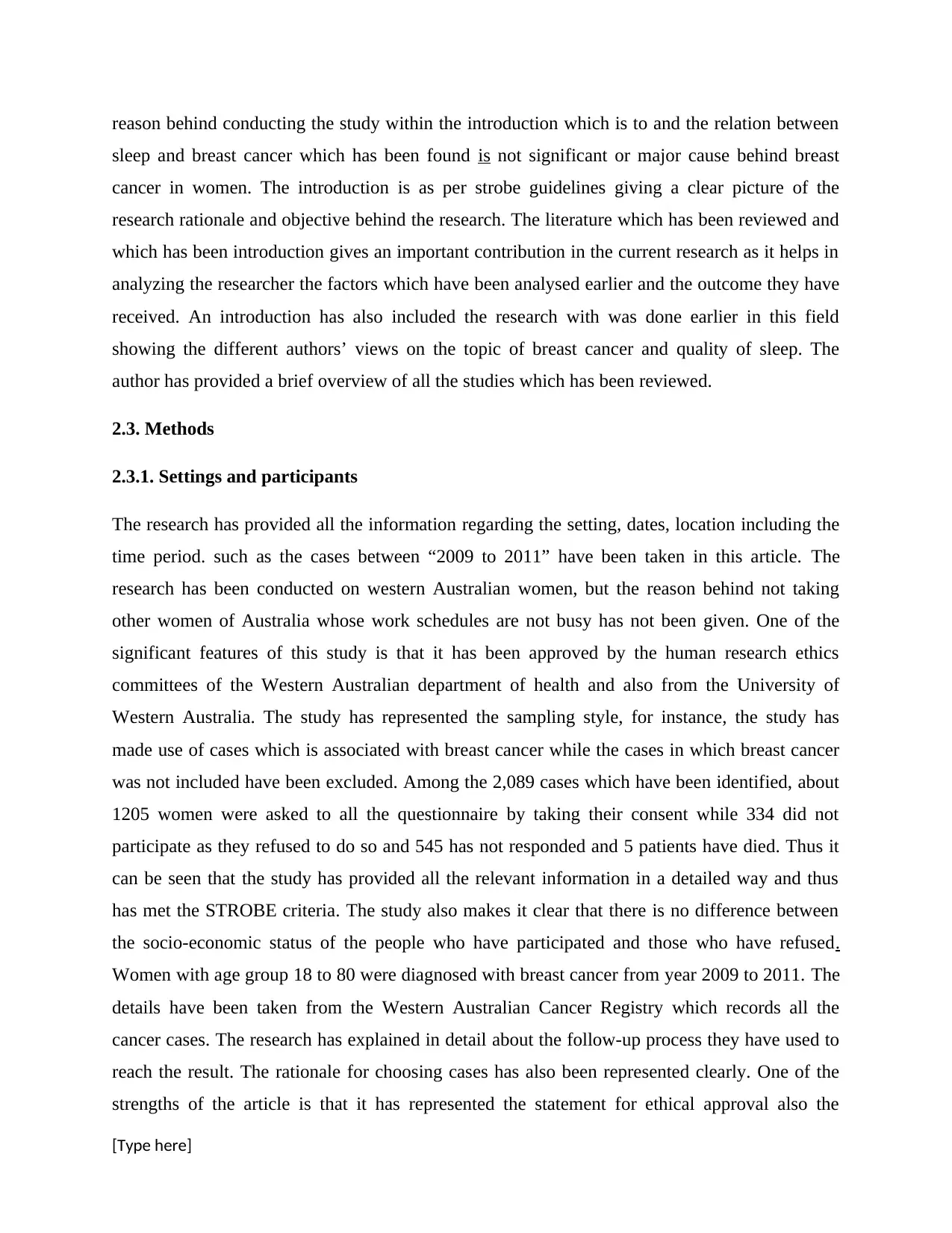
reason behind conducting the study within the introduction which is to and the relation between
sleep and breast cancer which has been found is not significant or major cause behind breast
cancer in women. The introduction is as per strobe guidelines giving a clear picture of the
research rationale and objective behind the research. The literature which has been reviewed and
which has been introduction gives an important contribution in the current research as it helps in
analyzing the researcher the factors which have been analysed earlier and the outcome they have
received. An introduction has also included the research with was done earlier in this field
showing the different authors’ views on the topic of breast cancer and quality of sleep. The
author has provided a brief overview of all the studies which has been reviewed.
2.3. Methods
2.3.1. Settings and participants
The research has provided all the information regarding the setting, dates, location including the
time period. such as the cases between “2009 to 2011” have been taken in this article. The
research has been conducted on western Australian women, but the reason behind not taking
other women of Australia whose work schedules are not busy has not been given. One of the
significant features of this study is that it has been approved by the human research ethics
committees of the Western Australian department of health and also from the University of
Western Australia. The study has represented the sampling style, for instance, the study has
made use of cases which is associated with breast cancer while the cases in which breast cancer
was not included have been excluded. Among the 2,089 cases which have been identified, about
1205 women were asked to all the questionnaire by taking their consent while 334 did not
participate as they refused to do so and 545 has not responded and 5 patients have died. Thus it
can be seen that the study has provided all the relevant information in a detailed way and thus
has met the STROBE criteria. The study also makes it clear that there is no difference between
the socio-economic status of the people who have participated and those who have refused.
Women with age group 18 to 80 were diagnosed with breast cancer from year 2009 to 2011. The
details have been taken from the Western Australian Cancer Registry which records all the
cancer cases. The research has explained in detail about the follow-up process they have used to
reach the result. The rationale for choosing cases has also been represented clearly. One of the
strengths of the article is that it has represented the statement for ethical approval also the
[Type here]
sleep and breast cancer which has been found is not significant or major cause behind breast
cancer in women. The introduction is as per strobe guidelines giving a clear picture of the
research rationale and objective behind the research. The literature which has been reviewed and
which has been introduction gives an important contribution in the current research as it helps in
analyzing the researcher the factors which have been analysed earlier and the outcome they have
received. An introduction has also included the research with was done earlier in this field
showing the different authors’ views on the topic of breast cancer and quality of sleep. The
author has provided a brief overview of all the studies which has been reviewed.
2.3. Methods
2.3.1. Settings and participants
The research has provided all the information regarding the setting, dates, location including the
time period. such as the cases between “2009 to 2011” have been taken in this article. The
research has been conducted on western Australian women, but the reason behind not taking
other women of Australia whose work schedules are not busy has not been given. One of the
significant features of this study is that it has been approved by the human research ethics
committees of the Western Australian department of health and also from the University of
Western Australia. The study has represented the sampling style, for instance, the study has
made use of cases which is associated with breast cancer while the cases in which breast cancer
was not included have been excluded. Among the 2,089 cases which have been identified, about
1205 women were asked to all the questionnaire by taking their consent while 334 did not
participate as they refused to do so and 545 has not responded and 5 patients have died. Thus it
can be seen that the study has provided all the relevant information in a detailed way and thus
has met the STROBE criteria. The study also makes it clear that there is no difference between
the socio-economic status of the people who have participated and those who have refused.
Women with age group 18 to 80 were diagnosed with breast cancer from year 2009 to 2011. The
details have been taken from the Western Australian Cancer Registry which records all the
cancer cases. The research has explained in detail about the follow-up process they have used to
reach the result. The rationale for choosing cases has also been represented clearly. One of the
strengths of the article is that it has represented the statement for ethical approval also the
[Type here]
⊘ This is a preview!⊘
Do you want full access?
Subscribe today to unlock all pages.

Trusted by 1+ million students worldwide
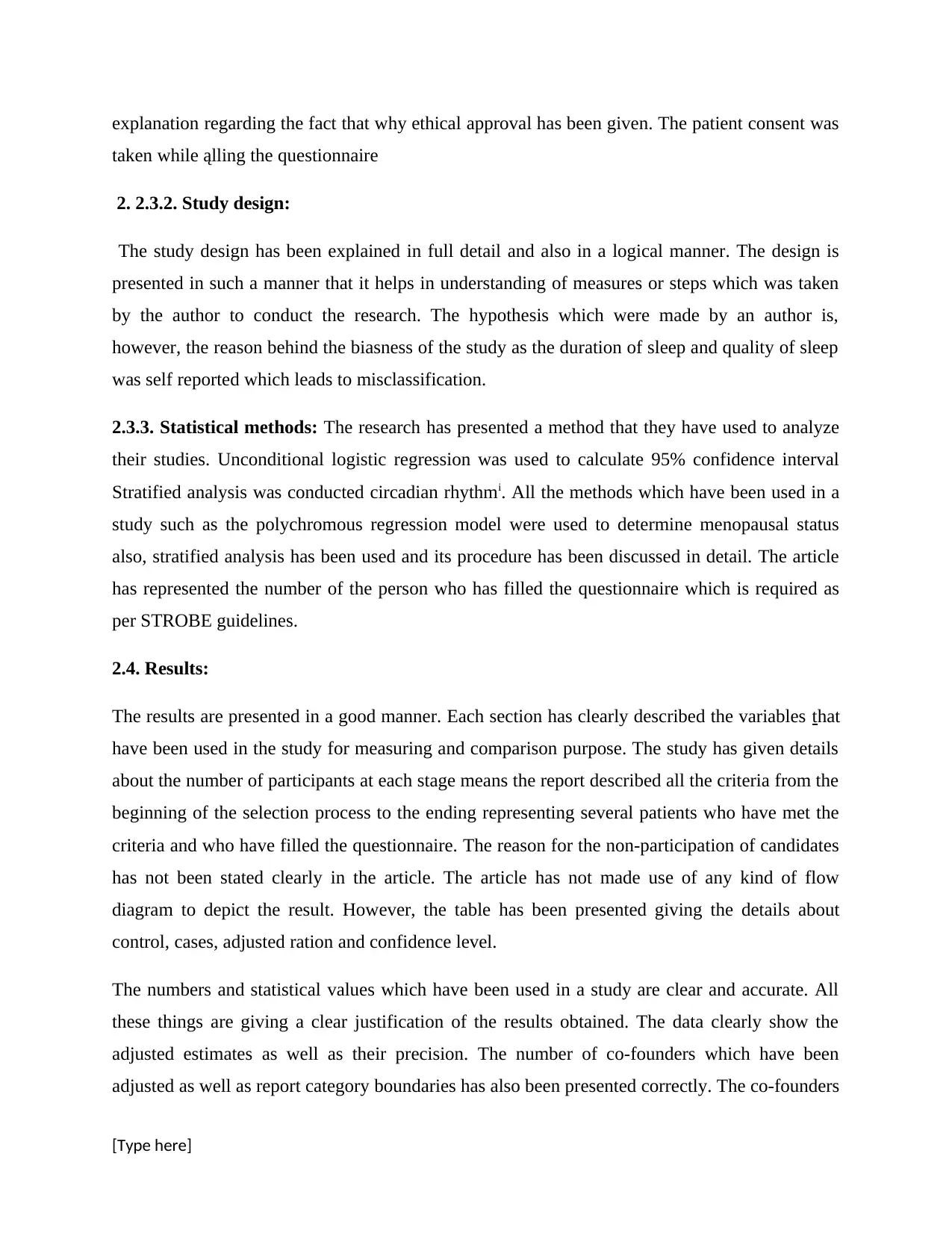
explanation regarding the fact that why ethical approval has been given. The patient consent was
taken while ąlling the questionnaire
2. 2.3.2. Study design:
The study design has been explained in full detail and also in a logical manner. The design is
presented in such a manner that it helps in understanding of measures or steps which was taken
by the author to conduct the research. The hypothesis which were made by an author is,
however, the reason behind the biasness of the study as the duration of sleep and quality of sleep
was self reported which leads to misclassification.
2.3.3. Statistical methods: The research has presented a method that they have used to analyze
their studies. Unconditional logistic regression was used to calculate 95% confidence interval
Stratified analysis was conducted circadian rhythmi. All the methods which have been used in a
study such as the polychromous regression model were used to determine menopausal status
also, stratified analysis has been used and its procedure has been discussed in detail. The article
has represented the number of the person who has filled the questionnaire which is required as
per STROBE guidelines.
2.4. Results:
The results are presented in a good manner. Each section has clearly described the variables that
have been used in the study for measuring and comparison purpose. The study has given details
about the number of participants at each stage means the report described all the criteria from the
beginning of the selection process to the ending representing several patients who have met the
criteria and who have filled the questionnaire. The reason for the non-participation of candidates
has not been stated clearly in the article. The article has not made use of any kind of flow
diagram to depict the result. However, the table has been presented giving the details about
control, cases, adjusted ration and confidence level.
The numbers and statistical values which have been used in a study are clear and accurate. All
these things are giving a clear justification of the results obtained. The data clearly show the
adjusted estimates as well as their precision. The number of co-founders which have been
adjusted as well as report category boundaries has also been presented correctly. The co-founders
[Type here]
taken while ąlling the questionnaire
2. 2.3.2. Study design:
The study design has been explained in full detail and also in a logical manner. The design is
presented in such a manner that it helps in understanding of measures or steps which was taken
by the author to conduct the research. The hypothesis which were made by an author is,
however, the reason behind the biasness of the study as the duration of sleep and quality of sleep
was self reported which leads to misclassification.
2.3.3. Statistical methods: The research has presented a method that they have used to analyze
their studies. Unconditional logistic regression was used to calculate 95% confidence interval
Stratified analysis was conducted circadian rhythmi. All the methods which have been used in a
study such as the polychromous regression model were used to determine menopausal status
also, stratified analysis has been used and its procedure has been discussed in detail. The article
has represented the number of the person who has filled the questionnaire which is required as
per STROBE guidelines.
2.4. Results:
The results are presented in a good manner. Each section has clearly described the variables that
have been used in the study for measuring and comparison purpose. The study has given details
about the number of participants at each stage means the report described all the criteria from the
beginning of the selection process to the ending representing several patients who have met the
criteria and who have filled the questionnaire. The reason for the non-participation of candidates
has not been stated clearly in the article. The article has not made use of any kind of flow
diagram to depict the result. However, the table has been presented giving the details about
control, cases, adjusted ration and confidence level.
The numbers and statistical values which have been used in a study are clear and accurate. All
these things are giving a clear justification of the results obtained. The data clearly show the
adjusted estimates as well as their precision. The number of co-founders which have been
adjusted as well as report category boundaries has also been presented correctly. The co-founders
[Type here]
Paraphrase This Document
Need a fresh take? Get an instant paraphrase of this document with our AI Paraphraser
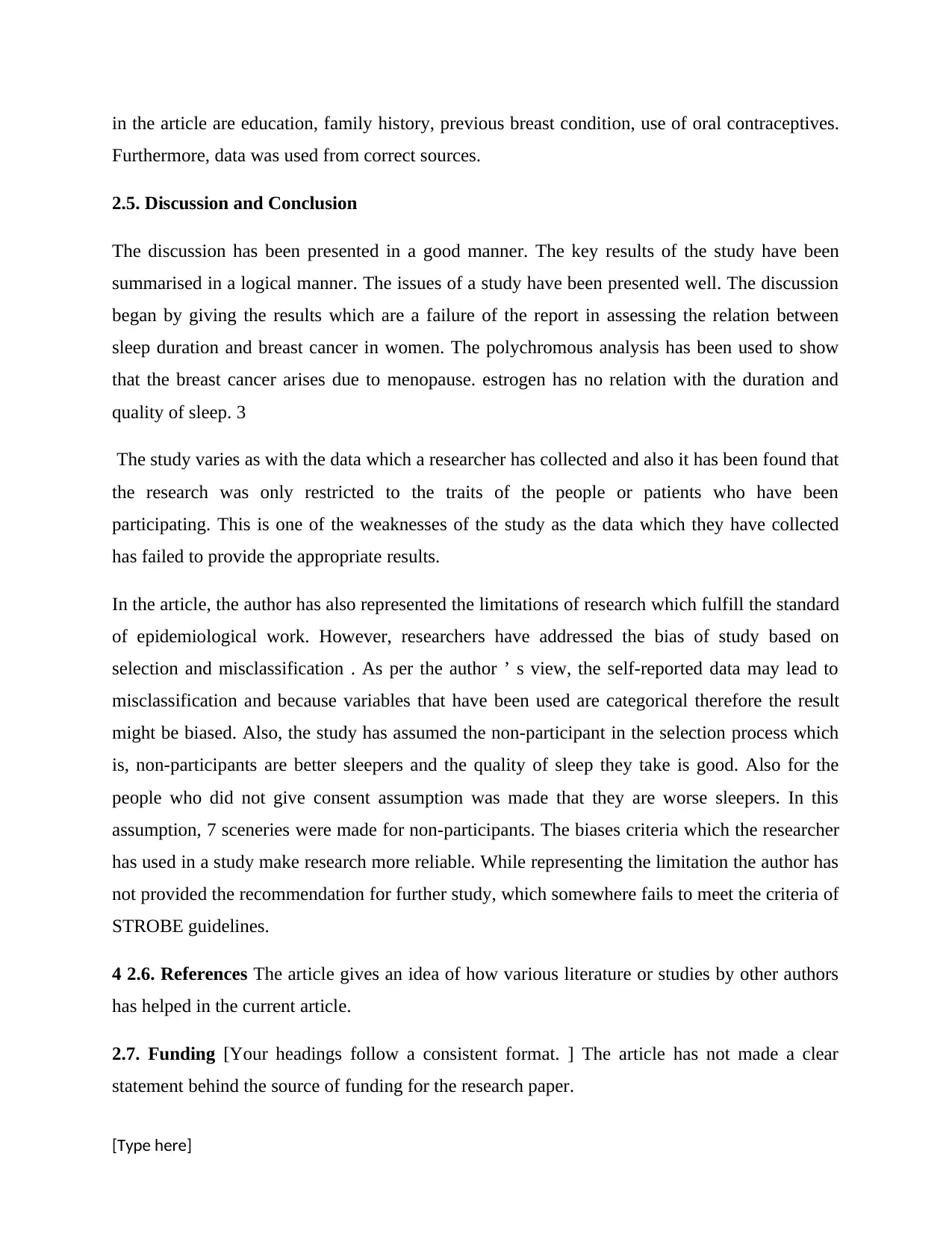
in the article are education, family history, previous breast condition, use of oral contraceptives.
Furthermore, data was used from correct sources.
2.5. Discussion and Conclusion
The discussion has been presented in a good manner. The key results of the study have been
summarised in a logical manner. The issues of a study have been presented well. The discussion
began by giving the results which are a failure of the report in assessing the relation between
sleep duration and breast cancer in women. The polychromous analysis has been used to show
that the breast cancer arises due to menopause. estrogen has no relation with the duration and
quality of sleep. 3
The study varies as with the data which a researcher has collected and also it has been found that
the research was only restricted to the traits of the people or patients who have been
participating. This is one of the weaknesses of the study as the data which they have collected
has failed to provide the appropriate results.
In the article, the author has also represented the limitations of research which fulfill the standard
of epidemiological work. However, researchers have addressed the bias of study based on
selection and misclassification . As per the author ’ s view, the self-reported data may lead to
misclassification and because variables that have been used are categorical therefore the result
might be biased. Also, the study has assumed the non-participant in the selection process which
is, non-participants are better sleepers and the quality of sleep they take is good. Also for the
people who did not give consent assumption was made that they are worse sleepers. In this
assumption, 7 sceneries were made for non-participants. The biases criteria which the researcher
has used in a study make research more reliable. While representing the limitation the author has
not provided the recommendation for further study, which somewhere fails to meet the criteria of
STROBE guidelines.
4 2.6. References The article gives an idea of how various literature or studies by other authors
has helped in the current article.
2.7. Funding [Your headings follow a consistent format. ] The article has not made a clear
statement behind the source of funding for the research paper.
[Type here]
Furthermore, data was used from correct sources.
2.5. Discussion and Conclusion
The discussion has been presented in a good manner. The key results of the study have been
summarised in a logical manner. The issues of a study have been presented well. The discussion
began by giving the results which are a failure of the report in assessing the relation between
sleep duration and breast cancer in women. The polychromous analysis has been used to show
that the breast cancer arises due to menopause. estrogen has no relation with the duration and
quality of sleep. 3
The study varies as with the data which a researcher has collected and also it has been found that
the research was only restricted to the traits of the people or patients who have been
participating. This is one of the weaknesses of the study as the data which they have collected
has failed to provide the appropriate results.
In the article, the author has also represented the limitations of research which fulfill the standard
of epidemiological work. However, researchers have addressed the bias of study based on
selection and misclassification . As per the author ’ s view, the self-reported data may lead to
misclassification and because variables that have been used are categorical therefore the result
might be biased. Also, the study has assumed the non-participant in the selection process which
is, non-participants are better sleepers and the quality of sleep they take is good. Also for the
people who did not give consent assumption was made that they are worse sleepers. In this
assumption, 7 sceneries were made for non-participants. The biases criteria which the researcher
has used in a study make research more reliable. While representing the limitation the author has
not provided the recommendation for further study, which somewhere fails to meet the criteria of
STROBE guidelines.
4 2.6. References The article gives an idea of how various literature or studies by other authors
has helped in the current article.
2.7. Funding [Your headings follow a consistent format. ] The article has not made a clear
statement behind the source of funding for the research paper.
[Type here]
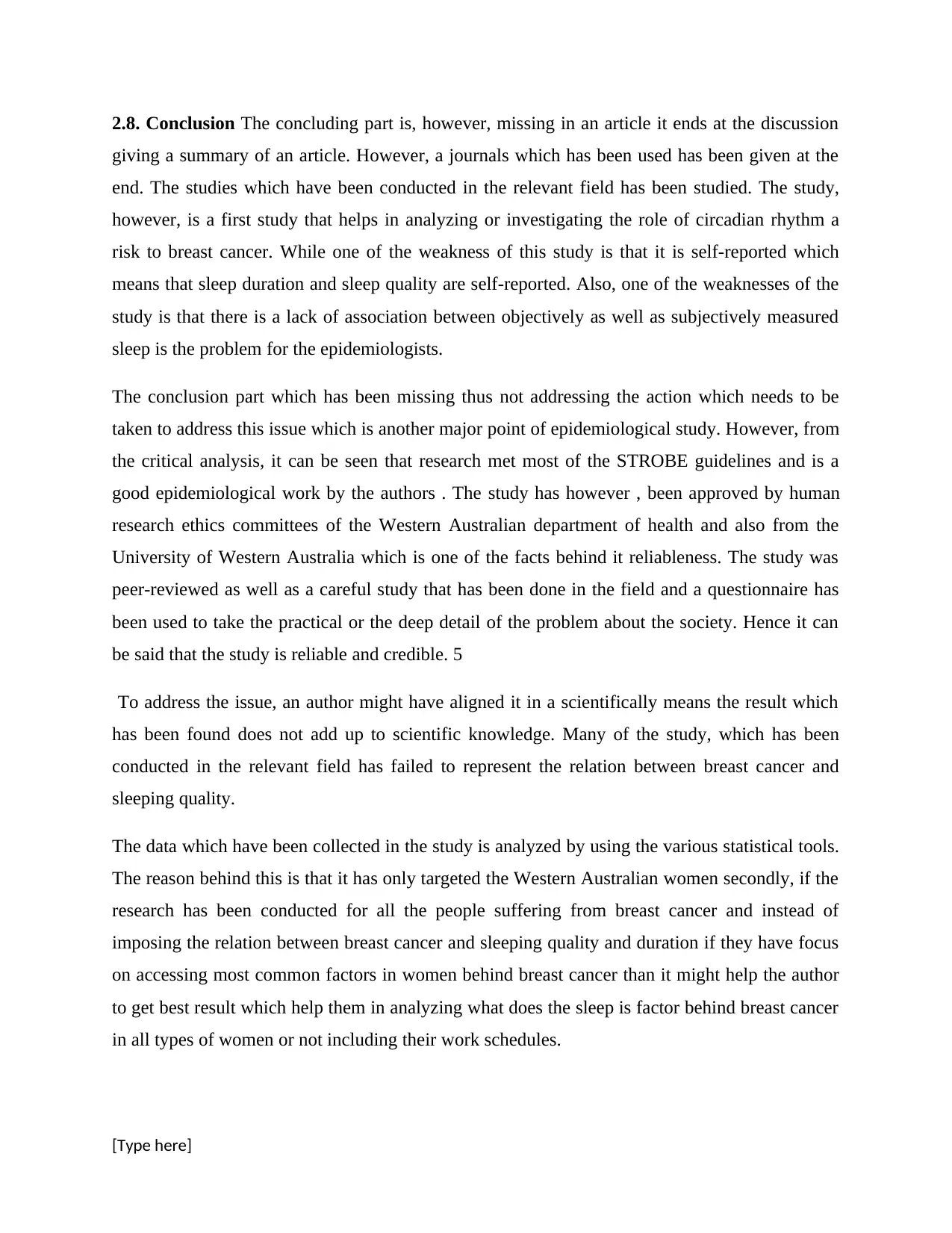
2.8. Conclusion The concluding part is, however, missing in an article it ends at the discussion
giving a summary of an article. However, a journals which has been used has been given at the
end. The studies which have been conducted in the relevant field has been studied. The study,
however, is a first study that helps in analyzing or investigating the role of circadian rhythm a
risk to breast cancer. While one of the weakness of this study is that it is self-reported which
means that sleep duration and sleep quality are self-reported. Also, one of the weaknesses of the
study is that there is a lack of association between objectively as well as subjectively measured
sleep is the problem for the epidemiologists.
The conclusion part which has been missing thus not addressing the action which needs to be
taken to address this issue which is another major point of epidemiological study. However, from
the critical analysis, it can be seen that research met most of the STROBE guidelines and is a
good epidemiological work by the authors . The study has however , been approved by human
research ethics committees of the Western Australian department of health and also from the
University of Western Australia which is one of the facts behind it reliableness. The study was
peer-reviewed as well as a careful study that has been done in the field and a questionnaire has
been used to take the practical or the deep detail of the problem about the society. Hence it can
be said that the study is reliable and credible. 5
To address the issue, an author might have aligned it in a scientifically means the result which
has been found does not add up to scientific knowledge. Many of the study, which has been
conducted in the relevant field has failed to represent the relation between breast cancer and
sleeping quality.
The data which have been collected in the study is analyzed by using the various statistical tools.
The reason behind this is that it has only targeted the Western Australian women secondly, if the
research has been conducted for all the people suffering from breast cancer and instead of
imposing the relation between breast cancer and sleeping quality and duration if they have focus
on accessing most common factors in women behind breast cancer than it might help the author
to get best result which help them in analyzing what does the sleep is factor behind breast cancer
in all types of women or not including their work schedules.
[Type here]
giving a summary of an article. However, a journals which has been used has been given at the
end. The studies which have been conducted in the relevant field has been studied. The study,
however, is a first study that helps in analyzing or investigating the role of circadian rhythm a
risk to breast cancer. While one of the weakness of this study is that it is self-reported which
means that sleep duration and sleep quality are self-reported. Also, one of the weaknesses of the
study is that there is a lack of association between objectively as well as subjectively measured
sleep is the problem for the epidemiologists.
The conclusion part which has been missing thus not addressing the action which needs to be
taken to address this issue which is another major point of epidemiological study. However, from
the critical analysis, it can be seen that research met most of the STROBE guidelines and is a
good epidemiological work by the authors . The study has however , been approved by human
research ethics committees of the Western Australian department of health and also from the
University of Western Australia which is one of the facts behind it reliableness. The study was
peer-reviewed as well as a careful study that has been done in the field and a questionnaire has
been used to take the practical or the deep detail of the problem about the society. Hence it can
be said that the study is reliable and credible. 5
To address the issue, an author might have aligned it in a scientifically means the result which
has been found does not add up to scientific knowledge. Many of the study, which has been
conducted in the relevant field has failed to represent the relation between breast cancer and
sleeping quality.
The data which have been collected in the study is analyzed by using the various statistical tools.
The reason behind this is that it has only targeted the Western Australian women secondly, if the
research has been conducted for all the people suffering from breast cancer and instead of
imposing the relation between breast cancer and sleeping quality and duration if they have focus
on accessing most common factors in women behind breast cancer than it might help the author
to get best result which help them in analyzing what does the sleep is factor behind breast cancer
in all types of women or not including their work schedules.
[Type here]
⊘ This is a preview!⊘
Do you want full access?
Subscribe today to unlock all pages.

Trusted by 1+ million students worldwide
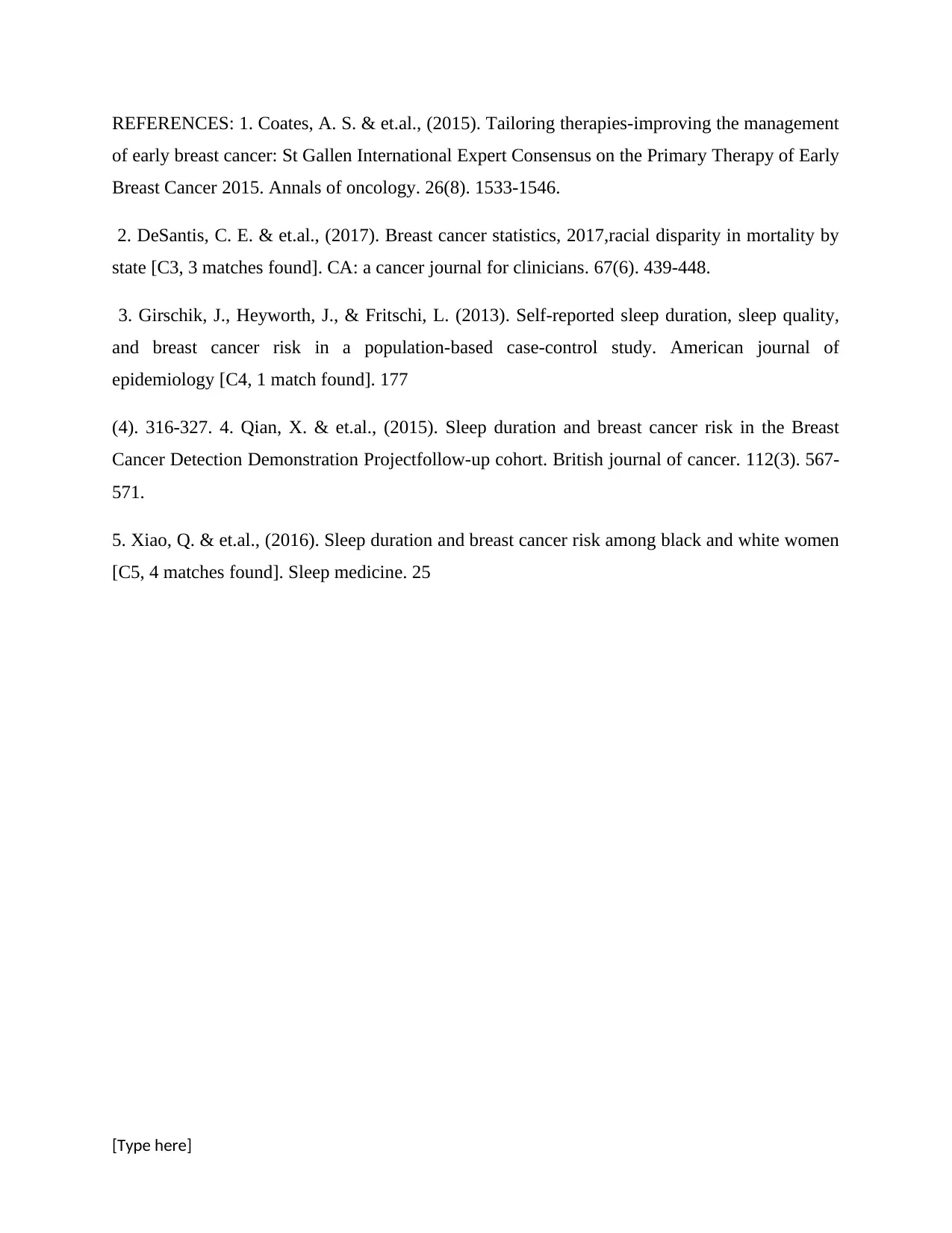
REFERENCES: 1. Coates, A. S. & et.al., (2015). Tailoring therapies-improving the management
of early breast cancer: St Gallen International Expert Consensus on the Primary Therapy of Early
Breast Cancer 2015. Annals of oncology. 26(8). 1533-1546.
2. DeSantis, C. E. & et.al., (2017). Breast cancer statistics, 2017,racial disparity in mortality by
state [C3, 3 matches found]. CA: a cancer journal for clinicians. 67(6). 439-448.
3. Girschik, J., Heyworth, J., & Fritschi, L. (2013). Self-reported sleep duration, sleep quality,
and breast cancer risk in a population-based case-control study. American journal of
epidemiology [C4, 1 match found]. 177
(4). 316-327. 4. Qian, X. & et.al., (2015). Sleep duration and breast cancer risk in the Breast
Cancer Detection Demonstration Projectfollow-up cohort. British journal of cancer. 112(3). 567-
571.
5. Xiao, Q. & et.al., (2016). Sleep duration and breast cancer risk among black and white women
[C5, 4 matches found]. Sleep medicine. 25
[Type here]
of early breast cancer: St Gallen International Expert Consensus on the Primary Therapy of Early
Breast Cancer 2015. Annals of oncology. 26(8). 1533-1546.
2. DeSantis, C. E. & et.al., (2017). Breast cancer statistics, 2017,racial disparity in mortality by
state [C3, 3 matches found]. CA: a cancer journal for clinicians. 67(6). 439-448.
3. Girschik, J., Heyworth, J., & Fritschi, L. (2013). Self-reported sleep duration, sleep quality,
and breast cancer risk in a population-based case-control study. American journal of
epidemiology [C4, 1 match found]. 177
(4). 316-327. 4. Qian, X. & et.al., (2015). Sleep duration and breast cancer risk in the Breast
Cancer Detection Demonstration Projectfollow-up cohort. British journal of cancer. 112(3). 567-
571.
5. Xiao, Q. & et.al., (2016). Sleep duration and breast cancer risk among black and white women
[C5, 4 matches found]. Sleep medicine. 25
[Type here]
Paraphrase This Document
Need a fresh take? Get an instant paraphrase of this document with our AI Paraphraser

i Coates, A. S. & et.al., (2015). Tailoring therapies-improving the management of early breast cancer: St
Gallen International Expert Consensus on the Primary Therapy of Early Breast Cancer 2015. Annals of
oncology. 26(8). 1533-1546
Gallen International Expert Consensus on the Primary Therapy of Early Breast Cancer 2015. Annals of
oncology. 26(8). 1533-1546
1 out of 8
Related Documents
Your All-in-One AI-Powered Toolkit for Academic Success.
+13062052269
info@desklib.com
Available 24*7 on WhatsApp / Email
![[object Object]](/_next/static/media/star-bottom.7253800d.svg)
Unlock your academic potential
Copyright © 2020–2025 A2Z Services. All Rights Reserved. Developed and managed by ZUCOL.





